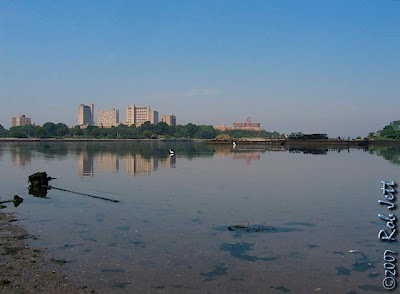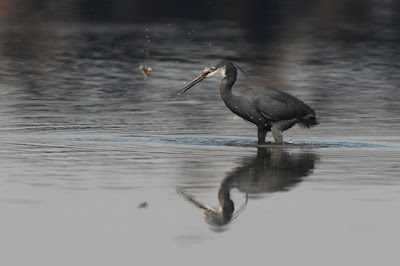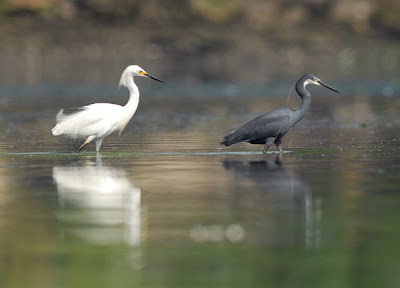
I know that there are people who read this blog who live far from New York City. It must seem odd to those folks how relatively often I write about some rare, exotic species showing up within or close to the city's borders. I'm a native New Yorker and have no problem admitting that this place is a little different, but exotic isn't a word I'd associate with The Big Apple. In some instances the rare sightings are attributed to our unique topography, the shape and orientation of the New York/New Jersey Bight, ocean currents, weather patterns or the numerous job opportunities. And then there are times when nobody even bothers trying to figure it out.
Monday morning Sean picked me up on his way to Calvert Vaux Park near Coney Island. On Sunday Alex Wilson had discovered a Western Reef Heron feeding in Coney Island Creek at low tide. The presence of a birder at the creek is almost as unusual as that species of wading bird. Anyway, Doug called at about 7am to let me know that it was still present.

I've posted a few times about Calvert Vaux Park only it was under its maiden name: Dreier-Offerman Park. Located just south of the Verazanno Bridge and north of Coney Island, the park is a manmade (or at least man-expanded) peninsula. It looks out onto Gravesend Bay and Coney Island Creek creates a tidal mudflat near the park's south end.
People who had arrived at the park early were in the park looking south at the heron. Doug called us and recommended that we park at "Toys-R-Us" and approach the creek from the opposite side, with the sun at or back. It was great advice as we had well lit, close views of the heron.

The heron is primarily a stunning blue-gray coloration. His throat is white and the top of his head has a single, long plume reminiscent of "Alfalfa" of "The Little Rascals". Approximately the same size as a Snowy Egret, he similarly has bright orange feet contrasting with dark legs.
It hadn't occured to me that I was observing the heron while squishing around in sandles in mud that was, in all likelihood, chockful of toxins. I was just so fascinated by one of his foraging techniques. While standing in shallow water, he would rapidly vibrate one of his legs, presumably by shuffling his foot in the mud. The motion would either attract prey or flush them up off of the bottom. Either way, he'd spot something tasty and snap it up with his dagger-like bill.

(Photo credit - Sean Sime)

(Photo credit - Sean Sime)
In my excitement to run out and see the bird I overlooked one small item; I didn't know anything about it and it wasn't in any of my North American guides. Sean knew just slightly more and most of the people I asked at the creek were also uninformed. So why all the hubbub? The bird had been reported in New Jersey and I guess word filter down that it was "special".
The Western Reef Heron's range includes west Africa, the Red Sea, the Persian Gulf and India. The bird near Coney Island is only the 4th record in the United States. This bird is a mystery to me. We know that he flew here, but why? I have also learned that biologists aren't even certain of his identity. I'll spare you the confusing details, but lets just say they can't decide who is a cousin and who is a sibling. A Snowy Egret seemed to have some problems with the foreign visitor and frequently displayed aggressive behavior towards him. Maybe this species of wading bird is just following in the footsteps, or rather, wingbeats of the Cattle Egret.
Click to view video of Western Reef Heron "shuffling"
While video is playing, click menu for a list of related videos

If you were stepping in toxins.. then those poor birds were wading in them?
ReplyDeletesigh.
To be fair, unlike the herons, my feet weren't eating the fish. The following is from a meeting transcript about a proposed Waste Transfer Station next to the creek. It describes what was found in the creek's mud.
ReplyDelete"...acute toxicity levels of lead, mercury and pesticides. By their own testing, they have indicated that the samples contain moderate contamination of arsenic, cadmium and copper, PAHs and PCPs."
My feet just fell off...
quite a migration to such a toxic shore.
ReplyDelete(on an unrelated note, I don't know if you've seen the young red-tailed hawk that has been hanging about in the southern (SW) part of Long Meadow recently. I don't know if s/he is known and named, but I have seen the Hawk perched near Dog Beach, on a shattered tree behind two baseball diamonds (on path to Dog Beach) and today on a large Gingko tree at the lowest entrance to Long Meadow (near PPSW and 10th Ave). The bird's chest is white with dark streaks at the lower belly, the reddish-rufuos color on its nape is somewhat on the fainter side. In my very limited experience, I would venture a guess that the hawk is a juvenile based on Sibleys and some web-research. Any thought from your end?)
NSC,
ReplyDeleteIt's probably one of the juveniles from the Ravine nest; or should I say, it's one of Alice & Ralph's kids. They've been hanging around the wooded area from the Ravine on back to the Quaker Cemetery. It takes two years for them to attain the red tail and the current season's offspring will have a rusty wash on their breast for a few weeks.
Thanks Rob. That sounds right on. So Alice and Ralph are the current nest in the Park with Big Mama and Junior having moved down to Greenwood, if I recall your posts accurately. Your blog is a great resource for individuals like me who are trying to bird and learn the basics. Its pretty quiet in the Park these days (aside from your Acadian Flycatcher...) though I got an amazing view of a Cedar Waxwing yesterday, about 50 feet south of Dog Beach. I look forward to the next migration but in the meantime will educate myself with your botanical observations and misguided African herons adventures! Thanks, Neal.
ReplyDeleteHi Jeff
ReplyDeleteI came upon your blog while googling "hawk" and "brooklyn", then I scrolled down to your friend's kestrel sighting...I live on Henry Street at Congress in Cobble Hill and twice in the last two weeks have seen a very small bird of prey sitting on a TV aerial across the road, besieged by mockingbirds (whose spot it usually is). And both time s/he is eating something s/he has just caught. Twice the mockingbirds have actualy dislodged the kestrel(?) who has flown away, but I have seen it return to the roof of the building that is part of the Long Island City Hospital, on the corner of Henry and Congress. There are masses of pigeons breeding there, and possibly it was catching fledglings? Anyway - what sort of kestrel would it be, do you think? I like your blog very much - I don't know enough about N. American birds, being South African...
My blog is 66squarefeet.blogspot.com but may be of little interest you. No birds. Mostly gardening/food/goings-on...
Marie
Great Blog!
ReplyDelete